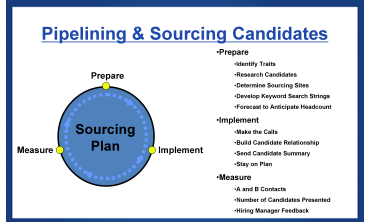 Our recruiting team has been examining its existing processes. This evaluation discovered that even though a firm foundation existed, each recruiter managed the recruiting life cycle differently. With this realization, each recruiter was charged with blueprinting their individual process. They presented their findings and through a collaborative workshop, developed a uniform recruiting workflow that created standardization at each critical recruiting touch-point. They also focused on increasing and improving dialogue with the hiring managers.
Our recruiting team has been examining its existing processes. This evaluation discovered that even though a firm foundation existed, each recruiter managed the recruiting life cycle differently. With this realization, each recruiter was charged with blueprinting their individual process. They presented their findings and through a collaborative workshop, developed a uniform recruiting workflow that created standardization at each critical recruiting touch-point. They also focused on increasing and improving dialogue with the hiring managers.
The impact of these changes, which I’m writing about in the July/August issue of the Journal of Corporate Recruiting Leadership, resulted in the team’s ability to deliver a consistent and recognizable recruiting experience, facilitate increased communication opportunities with hiring managers regarding their position/candidate status, deliver a consistent approach from which accurate and objective metrics can be applied, and allow for dynamic job postings (which increase candidate interest more than standard static postings).
With the process reengineered and hiring managers fully engaged, the recruiting team had a better understanding of the positions they were working on and are able to more quickly respond to the managers’ needs. This positioning allowed for the final phase of the process improvement effort: pipelining talent. With a better understanding of our business owners’ needs and a process that dramatically shortened our time to fill, the recruiters were able to become proactive instead of reactive.
The team used its newly acquired knowledge to begin pipelining efforts to strategically source frequently needed talent. The pipelining implementation started by targeting critical business areas such as Sales and Operations. Pipelining talent required new skills to be developed and used by the recruiting team. Time was spent shifting the current mindset from “filling” to “sourcing,” asking probing questions about a candidate’s potential versus ability to perform a specific task, and creating relationships versus selling a position (see the graphic).

Recruiters began to research candidates through various sourcing methods, developed comprehensive search strings, and continued to work with our internal business partners to anticipate future openings for these newly sourced individuals.
This focus on our sourcing efforts resulted in a 30% increase in visits to our careers site in a one-year period and an increase in our applicant pool by 23% in the same period of time.
With the process streamlined and the support systems in alignment with the overall strategy, the next area the recruiting team addressed was education and training. Training was focused on hiring managers. The first deliverable for this group was the creation of an online Hiring Managers Guide that was accessible to all Freeman managers and supervisors.
The guide clearly articulated Freeman’s hiring process, and provided helpful interview techniques and document templates for use throughout the hiring process. Immediately following the deployment of the hiring guide was a series of recruiting webinars which covered topics on our company’s hiring process, available recruiting resources, interviewing techniques, and specialized sessions — such as “Face-to-Face Interview Techniques” — focused on building the managers’ recruiting skill-sets.
With the goal of improving the partnering relationship, each hiring manager was given a survey to establish a delivery expectation baseline from which recruiting goals would be developed. A SWOT analysis was also completed. The newly initiated partnering approach resulted in a 94% overall recruiting department satisfaction rate.
As I mentioned above, I’ll talk more about it in the July/August Journal.